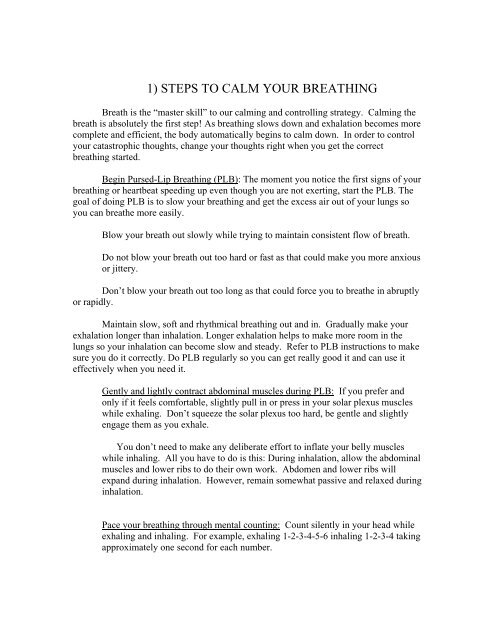Anxiety and Panic Attacks In Emphysema ... - Mind Publications
Anxiety and Panic Attacks In Emphysema ... - Mind Publications
Anxiety and Panic Attacks In Emphysema ... - Mind Publications
You also want an ePaper? Increase the reach of your titles
YUMPU automatically turns print PDFs into web optimized ePapers that Google loves.
1) STEPS TO CALM YOUR BREATHING<br />
Breath is the “master skill” to our calming <strong>and</strong> controlling strategy. Calming the<br />
breath is absolutely the first step! As breathing slows down <strong>and</strong> exhalation becomes more<br />
complete <strong>and</strong> efficient, the body automatically begins to calm down. <strong>In</strong> order to control<br />
your catastrophic thoughts, change your thoughts right when you get the correct<br />
breathing started.<br />
Begin Pursed-Lip Breathing (PLB): The moment you notice the first signs of your<br />
breathing or heartbeat speeding up even though you are not exerting, start the PLB. The<br />
goal of doing PLB is to slow your breathing <strong>and</strong> get the excess air out of your lungs so<br />
you can breathe more easily.<br />
Blow your breath out slowly while trying to maintain consistent flow of breath.<br />
Do not blow your breath out too hard or fast as that could make you more anxious<br />
or jittery.<br />
Don’t blow your breath out too long as that could force you to breathe in abruptly<br />
or rapidly.<br />
Maintain slow, soft <strong>and</strong> rhythmical breathing out <strong>and</strong> in. Gradually make your<br />
exhalation longer than inhalation. Longer exhalation helps to make more room in the<br />
lungs so your inhalation can become slow <strong>and</strong> steady. Refer to PLB instructions to make<br />
sure you do it correctly. Do PLB regularly so you can get really good it <strong>and</strong> can use it<br />
effectively when you need it.<br />
Gently <strong>and</strong> lightly contract abdominal muscles during PLB: If you prefer <strong>and</strong><br />
only if it feels comfortable, slightly pull in or press in your solar plexus muscles<br />
while exhaling. Don’t squeeze the solar plexus too hard, be gentle <strong>and</strong> slightly<br />
engage them as you exhale.<br />
You don’t need to make any deliberate effort to inflate your belly muscles<br />
while inhaling. All you have to do is this: During inhalation, allow the abdominal<br />
muscles <strong>and</strong> lower ribs to do their own work. Abdomen <strong>and</strong> lower ribs will<br />
exp<strong>and</strong> during inhalation. However, remain somewhat passive <strong>and</strong> relaxed during<br />
inhalation.<br />
Pace your breathing through mental counting: Count silently in your head while<br />
exhaling <strong>and</strong> inhaling. For example, exhaling 1-2-3-4-5-6 inhaling 1-2-3-4 taking<br />
approximately one second for each number.


